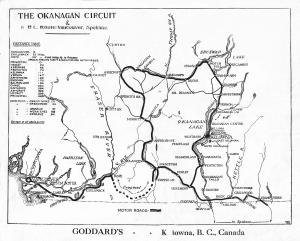How did one travel from the Okanagan to the coast in the first decades of the twentieth century? Crossing the coastal mountains was no easy task. The Dewdney Trail, connecting the South Okanagan to Hope, had been built during the Gold Rush, and for years supplies came into the Valley by pack train on that route. In 1865 the Cariboo Wagon Road was completed and steamers plied the Thompson and Spallumcheen rivers, discharging their passengers and goods at Fortune’s Landing (Enderby). This access to the north Okanagan was supplemented by a wagon road constructed from Kamloops to Priest’s Valley (Vernon) in 1871 and extended to the Mission in 1875, greatly improving transport in the region.
Railway construction in the 1880s was a huge boon to the province. The Canadian Pacific Railway (CPR) was completed in 1885, the Shuswap and Okanagan branch line to Okanagan Landing was finished in May 1892, and thereafter lake boats connected lakeside communities like Okanagan Centre to the outside world. The Okanagan’s dependence on rail traffic was further advanced by the building of the Kettle Valley line which connected Penticton to the CPR mainline at Hope.
This railway building had the unfortunate result of eliminating the Cariboo Wagon Road through the Fraser Canyon. For the next forty years, persons driving to the Coast had to travel through American territory, as William Traill Heddle did in 1916. Okanagan drivers could travel extensively in the interior of BC and they could connect with Spokane, Portland or Seattle, but it was very time consuming to reach Vancouver. Only when the automobile became a common mode of transport was this situation alleviated.

The accompanying map, published in Kelowna in 1926, illustrates the problem.
The Fraser Canyon Highway was constructed in 1924-5 and when the Alexandra Bridge across the Fraser River was finally opened in 1926, communities in the Okanagan and the rest of the interior were connected directly to the coast.







0 Comments